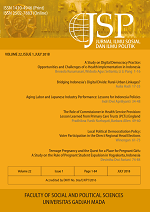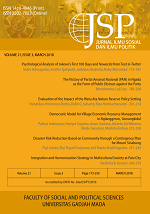Persecution Act as Filter Bubble Effect: Digital Society and The Shift of Public Sphere
Arina Rohmatul Hidayah(1*)
(1) Department of Communications Science, Faculty of Social and Political Sciences, Universitas Gadjah Mada
(*) Corresponding Author
Abstract
This article discusses persecution acts associated with the filter bubble effect, the condition of digital society, the concept of the public sphere and the rational action theory of Jurgen Habermas. The results, obtained through the literature research method, show that acts of persecution in social media can be caused by the personalization of the web. Social media allows the occurrence of large bubbles (filter bubbles) that make users reject ideologies or other truths. This becomes a revolution of mindset due to the freedom of information. Meanwhile, in the Habermas public sphere concept, which emphasizes the existence of a critical and rational discussion, this phenomenon indicates a shift. The shift that occurs brings about the lifeworld realm as the basis for the formation of the public sphere with its communicative action, again dominated by the system realm that is dominated by capitalist forces through strategic action. Thus, Habermas's initial goal of strengthening civil society's position against the dominance of the system is now changing.
Keywords
Full Text:
PDFReferences
Adam, A. (2017). Filter Bubble: Sisi Gelap Algoritma Media Sosial. December 17, 2017, retrieved fromhttps://tirto.id/filter-bubble-sisi-gelap-algoritma-media-sosial-cwSU
Allcott, H. & Gentzkow, M. (2017). Social Media and Fake News in the 2016 Election. Journal of Economic Perspective, 31(2), 211-236. doi: =10.1257/jep.31.2.211
Arti Persekusi. (2017, December 17). Retrieved from https://kbbi.web.id/persekusi
Azali, K. (2017). Fake News and Increased Persecution in Indonesia. ISEAS Yusof Ishak Institute, 61, 1-10. Retrieved from https://www.iseas.edu.sg/images/pdf/ISEAS_Perspective_2017_61.pdf
Bank, N., Z. (2014). Social Media and Its Effects On Individuals and Social System. Human Capital Without Borders: Knowledge and Learning for Quality of Life. International Conference. Retrieved fromhttp://www.toknowpress.net/ISBN/978-961-6914-09-3/papers/ML14-714.pdf
Becla, A. (2012). Information Society and Knowledge - Based Economy - Development Level and The Main Barriers - Some Remarks. Interdisciplinary Approach to Economics and Sociology, 5 (1), 125-132. Retrieved fromhttp://www.economics-sociology.eu/files/Agnieszka%20Becla%20V5N1.pdf
Bozdag, E. & Hoven, J. v. d. (2015). Breaking The Filter Bubble: Democracy and Design. Ethics Inf. Technol, 1-17. doi: 10.1007/s10676-015-9380-y.
Cadwalladr, C. & Harrison, E., G. (2018). Revealed: 50 Million Facebook Profiles Harvested for Cambridge Analytica in Major Data Breach. 7 May 2018, retrieved from https://www.theguardian.com/news/2018/mar/17/cambridge-analytica-Facebook-influence-us-election
Caplan, R. & Boyd, D. (2016). Who Controls the Public Sphere in An Era of Algorithms?. Mediation, Automation, Power, 1-19. Retrieved fromhttps://datasociety.net/pubs/ap/MediationAutomationPower_2016.pdf
Charles, G.,-U. & Rohwer, L., F. (2015). Habermas, the Public Sphere, and the Creation of a Racial Counterpublic. Michigan Journal of Race and Law, 21 (1), 1-21. Retrieved fromhttps://repository.law.umich.edu/cgi/viewcontent.cgi?referer=https://www.google.co.id/&httpsredir=1&article=1048&context=mjrl
Debora, Y. (2017). Kronologi Kasus Dugaan Penistaan Agama. Mei 1 2018, retrieved from https://tirto.id/kronologi-kasus-dugaan-penistaan-agama-b457
Facebook FPI Picu Kekerasan atau Menyebar Pesan Kemanusiaan?. January 31 2018, retrieved from www.bbc.com/indonesia/indonesia-42442733
Fuchs, C. (2014). Social Media and The Public Sphere. Triple C, 12 (1), 57-101. Retrieved fromhttp://www.triple-c.at/index.php/tripleC/article/viewFile/552/529
Freyne, J., Daly, E., M., Berkovsky, S., & Geyer, W. (2010). Social Networking Feeds: Recommending Items of Interest. Proceedings of the 2010 ACM Conference on Recommender Systems, 277-280. doi: 10.1145/ 1864708.1864766
Gooch, A. (2017). In Pursuit of the Truth. In UNO Magazine "The Post-Truth Era: Reality vs. Perception"(pp. 14-15). Spain: Llorente & CUENCA
Granville, K. (2018). Facebook and Cambridge Analytica: What You Need to Know as Fallout Widens. 7 May 2018, retrieved fromhttps://www.nytimes.com/2018/03/19/technology/Facebook-cambridge-analytica-ex plained.html
Gual, M. (2017). Korban Persekusi ‘The Ahok Effect’ Tercatat Mencapai 59 Orang. December 17 2017, retrieved fromhttps://www.cnnindonesia.com/nasional/20170601163649-20-218744/korban-persekusi-the-ahok-effect-tercatat-mencapai-59-orang/.
Gunaratne, S., A. (2006). Public Sphere and Communicative Rationality: Interrogating Habermas’s Eurocentrism. Journalism & Mass Communication Monographs. 8 (2). 4-115. doi: 10.1177/152263790600800201
Guy, I., Zwerdling, N., Ronen, I., Carnel, D., & Uziel, E. (2010). Social Media Recommendation Based On People and Tags. SIGIR. Retrieved fromhttps://www.research.ibm.com/haifa/dept/imt/papers/guySIGIR10.pdf
Hansen, H., A., Bjorktomta, S., B., & Svalastog, L. (2017). Digital Society generates New Challenges On Child Welfare Services. Croat Med Journal, 58, 80-83. Retrieved fromhttp://neuron.mefst.hr/docs/CMJ/issues/2017/58/1/cmj_58_1_hansen_28252879.pdf
Hardiman, F., B. (2009). Demokrasi Deliberatif: Menimbang Negara Hukum dan Ruang Publik dalam Teori Diskursus Jurgen Habermas. Yogyakarta: Kanisius.
Holone, H. (2016). The Filter Bubble and Its Effect on Online Personal Health Information. Knowledge Landscapes, 57 (3), 298-301. doi: 10.3325/cmj.2016.57.298.
Jamilah, I., Akbar, K., F., Gunawan, M., A., & Marantika, S. (2016). Political Communication, Social Media, and Public Sphere: An Analysis to a Phenomenon in Bandung towards Smart City. International Journal of Social Science and Humanity, 6 (12), 923-928. DOI: 10.18178/ijssh.2016.6.12.774
Kamp, M. (Ed.). (2016). Reality Check Assessing The Impact of Social Media on Political Communication and Civic Engagement in Uganda. Uganda: Konrad Adenaur Stiftung:
Kernstock, J. & Brexendorf, T., O.. (2009). Implications of Habermas’s “theory of communicative action” for corporate brand management. Corporate Communications: An International Journal, 14 (4), 389-403. DOI: 10.1108/13563280910998745
Khan, M., Z., Gilani, I., S., & Nawaz, A. (2012). From Habermas Model to New Public Sphere: A Paradigm Shift. Global Journal of Human Social Science, 12 (5), 42-52. Retrieved fromhttps://globaljournals.org/GJHSS_Volume12/6-From-Habermas-Model-t o-New.pdf
Laidlaw, E., B. (2017). Online Shaming and The Right to Privacy. Journal of Laws, 6 (3), 1-26. DOI: 10.3390/laws6010003.
Lambert, M. (2016). Post-Truth Era and Impact on The Science Associated with Sport and Exercise Medicine. S Afr J Sports Med, 28 (3), 63. doi: 10.17159/2078-516X/2016/v28i3a1838.
Lin, G. (2009). Higher Education Research Methodology-Literature Method. International Education Studies, 2 (4), 179-181. Retrieved fromhttps://files.eric.ed.gov/fulltext/EJ1065734.pdf
Prakash, S. (2016). Filter Bubble: How to Burst Your Filter Bubble. International Journal Of Engineering And Computer Science, 5 (10), 18321-18325. doi: 10.18535/ijecs/v5i10.15
Rohmatin, T. (2016). Nilai-Nilai Pluralisme dalam Buku Pendidikan Agama Islam (PAI) untuk Sekolah Menengah Atas (SMA). Ilmu Ushuluddin, 3 (1), 133-152. Retrieved fromjournal.uinjkt.ac.id/index.php/ilmu-ushuluddin/article/download/4857/3305
Selamat Datang di Era Post-Truth. (2017, January 17). Retrieved from www.remotivi.or.id/kabar/345/Selamat-Datang-di-Era-Post-Truth.
Setiawan, I. (2017). Kajian Yuridis terhadap Persekusi, 5 (2). Retrieved from jurnal.unigal..ac.id
Vrachnas, J., Bagaric, M., Athula, P., & Dimoploulos, P. (2012). Migration and Refugee Law: Principles and Practice in Australia (3rd Ed.). New York: Cambridge University Press.
Yetkinel, O. & Colak, M. (2017). The Effects of Transformation of Public Sphere with the New Media in Academy. EURASIA Journal of Mathematics Science and Technology Education, 13 (8), 5009-5018. doi: 10.12973/eurasia.2017.00979a.
Article Metrics
Refbacks
- There are currently no refbacks.
Copyright (c) 2019 Jurnal Ilmu Sosial dan Ilmu Politik

This work is licensed under a Creative Commons Attribution-NonCommercial-NoDerivatives 4.0 International License.






















